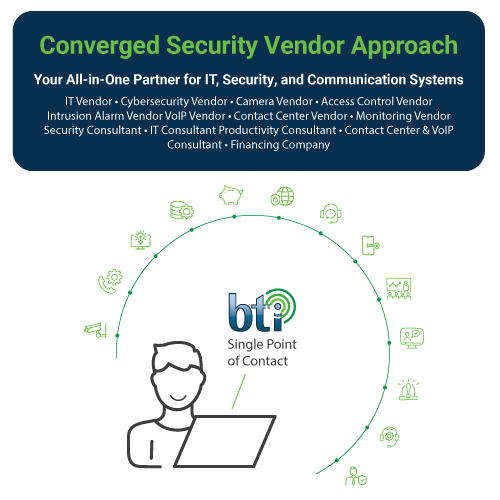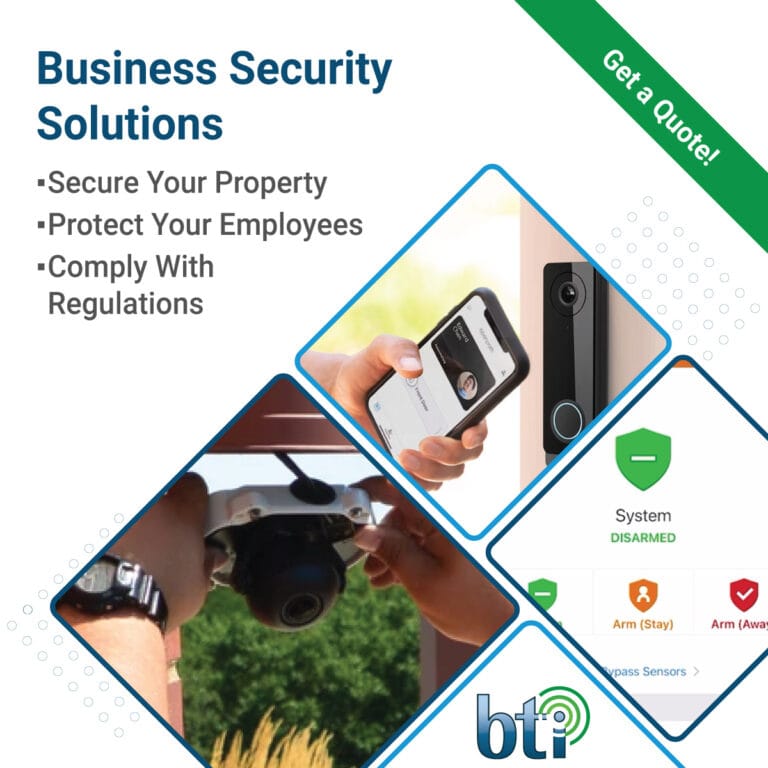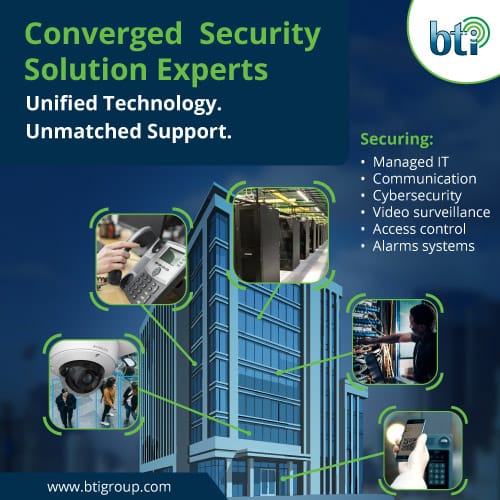Security convergence is the integration of physical security management and cybersecurity management solutions and personnel to improve security outcomes. Organizations increasingly face sophisticated threats from both the physical world and remote threat actors in cyberspace. Security convergence enables automated, monitored alerts to prevent both physical and cyber threat actors.
In this article, Eric Brackett, founder and president of BTI Communications Group will explain the concept of security convergence, its benefits, key areas of focus, and strategies for successful implementation, thus providing business owners with the insights needed to enhance their security framework.
The Importance of Converged Security

Understanding Security Convergence
Security convergence refers to the integration of physical security measures and alerts with cyber security measures and alerts.
By aligning these two domains, organizations can create a more robust security posture that addresses and correlates physical threats, like unauthorized access to facilities, and cyber threats, such as data breaches and ransomware attacks. Convergence of physical and cyber security not only enhances overall security but also promotes a culture of vigilance across the organization.
Moreover, the impact of security convergence extends beyond mere physical and digital protection. It fosters a synergy that enables organizations to respond more effectively to threats, streamline incident response times, and allocate resources efficiently. In an era where threats are increasingly interconnected, understanding and embracing security convergence is critical for business owners looking to safeguard their assets.
Benefits of Physical and Cyber Security Convergence
Physical and cyber security convergence can lead to significant benefits for organizations. By breaking down silos between physical and cyber security personnel, businesses can enhance communication and collaboration. Convergence of physical and cyber security fosters a more comprehensive understanding of potential threats, allowing for better preparedness and risk management. Additionally, having a unified security team minimizes redundancy and optimizes resource allocation, ultimately reducing operational costs.
Furthermore, a collaborative security environment promotes a culture of accountability and shared responsibility among employees. When teams work together, they can identify vulnerabilities more effectively and implement preventive measures. This proactive approach not only mitigates risks but also instills confidence among stakeholders, including clients and investors, that the organization is committed to maintaining a secure operational environment.
Key Areas of Focus for Converged Security
Physical Site Security
Physical site security encompasses measures designed to protect the physical infrastructure of an organization. This includes sensors, door access control systems, surveillance camera analytics, security personnel, and environmental controls. With the rise of cyber threats, physical security measures must be integrated with cyber protocols. For example, if an employee is in the office and a threat actor is seen attempting to use his/her credentials remotely, this should generate a high alert score.
In addition, separating the work between notification and security response from the technicians’ vulnerability management work can dramatically reduce cost and complexity in managing security. If an employee is connected remotely and someone uses their badge in the building, this should also generate a high alert score.
At a more fundamental level, converging physical and cybersecurity reduces risk of security system and IT and cyber defense failure. One of the most common failures in cyber is the breach of security systems and devices improperly managed by security companies without cybersecurity expertise. One of the most common and successful methods that physical burglars use is jamming or disabling power, wi-fi, and internet to prevent physical security systems from operating during a burglary. If alerts were monitored in a converged fashion, either incident would generate an immediate emergency response. When they are not converged, each one is a vulnerability to the other, not an asset.
Converged security also involves converged risk assessment. Increasingly regulations and industry compliance certifications require that physical and cybersecurity both be assessed regularly. Best practices and compliance success are both served by converged security practices and vendors. In many cases, the compliance burden can be cut in half and the compliance time spent is dramatically reduced.
Cyber Security
Cyber security is critical in protecting sensitive data and maintaining the integrity of systems. As organizations increasingly rely on digital platforms, the potential for cyber-attacks grows exponentially. To effectively integrate cyber security into the broader security framework, businesses must prioritize the implementation of robust security protocols, including strong password policies, encryption, and regular software updates.
Additionally, organizations should conduct regular penetration testing and vulnerability assessments to identify weaknesses in their cyber defenses. Understanding the evolving nature of cyber threats allows security teams to adapt their strategies and maintain an agile defense posture, ensuring the protection of both digital and physical assets.
IOT Connectivity
The Internet of Things (IoT) has transformed how businesses operate, but it has also opened new avenues for security threats. With an increasing number of devices connected to corporate networks, ensuring their security becomes paramount. IoT devices—such as smart cameras, sensors, and access controls—should be integrated into the organization’s overall security strategy.
To manage IoT security effectively, organizations must implement stringent protocols for device authentication, data encryption, and regular firmware updates. This proactive approach not only safeguards the devices but also protects the larger network from potential breaches, ensuring that physical security measures remain uncompromised.
Network Infrastructure
A secure network infrastructure is the backbone of any successful security strategy. This includes firewalls, intrusion detection systems, and secure access protocols. By integrating network security with physical security measures, organizations can create a layered defense strategy that minimizes risks. For example, a breach in physical security can trigger an immediate audit of network access for all connected devices.
Moreover, continuous monitoring and analysis of network traffic can help identify suspicious activities early, allowing organizations to respond promptly to potential threats. Collaborating with both physical and cyber security teams ensures a unified approach to incident response, making it easier to manage incidents and reduce their impact.
SAAS Security
As businesses increasingly adopt Software as a Service (SaaS) solution, understanding the security implications of these platforms is vital. SaaS applications often house sensitive data and can be prime targets for cybercriminals. To effectively integrate SaaS security, businesses must ensure that they understand the security posture of their SaaS providers and implement best practices for data protection.
Implementing Multi-Factor Authentication (MFA), regular audits of user access, and data encryption are essential steps to safeguard sensitive information stored within SaaS applications. Additionally, organizations should establish clear guidelines for employees on using SaaS solutions securely, ensuring that all staff members are aware of potential vulnerabilities and best practices for data protection.
VoIP Security
Voice over Internet Protocol (VoIP) systems have become a standard for business communication, but they also present unique security challenges. VoIP calls can be intercepted, and systems can be vulnerable to denial-of-service attacks. To integrate VoIP security effectively, organizations must implement encryption protocols, secure access controls, and regular audits of VoIP systems.
Moreover, training employees on recognizing potential threats, such as phishing attacks targeting VoIP systems, is vital. By fostering awareness and ensuring that VoIP systems are secured as part of the overall security strategy, organizations can protect their communications from unauthorized access and potential disruptions.
Compliance and Regulatory Needs
Compliance with industry regulations and standards is a critical aspect of security integration. Organizations must navigate various legal requirements, including data protection laws such as GDPR, HIPAA, and PCI DSS, to ensure they meet compliance standards. Integrating compliance considerations into the broader security framework helps organizations avoid costly penalties and reputational damage.
Regular audits, assessments, and updates to security policies are necessary to maintain compliance and adapt to changing regulations. Furthermore, organizations should invest in training programs to ensure that all employees understand compliance requirements and their role in maintaining security protocols.
HR and Employee Training
Human resources play a crucial role in establishing a secure organizational culture. Employee training and awareness are paramount in mitigating security risks, as human error is often a significant factor in security breaches. Organizations should prioritize ongoing training programs that focus on both physical and cyber security protocols, ensuring that employees are equipped with the knowledge and skills needed to recognize potential threats.
Additionally, fostering a culture of security awareness encourages employees to take ownership of their role in maintaining security. Encouraging open communication about security concerns can lead to prompt reporting of potential vulnerabilities and an overall more secure environment for the organization.
Technical Support Structures
Effective technical support structures are essential for managing integrated security systems. Organizations should ensure that they have the necessary expertise and resources to address security incidents promptly. This includes establishing a clear incident response plan that outlines the roles and responsibilities of security personnel, IT teams, and management in the event of a security breach.
Moreover, leveraging advanced monitoring tools and analytics can enhance the organization’s ability to detect and respond to security incidents in real time. By implementing a structured approach to technical support, organizations can minimize the impact of security breaches and maintain operational continuity.
Leveraging Security Convergence for Enhanced Security
Automation in Security Processes
Automation is revolutionizing security processes, enabling organizations to streamline operations and reduce the risk of human error. By automating routine security tasks, such as monitoring, incident reporting, and vulnerability assessments, organizations can enhance their overall security posture. Automation allows security teams to focus on more strategic initiatives while ensuring that essential processes are consistently executed.
For instance, automated systems can analyze vast amounts of data in real time to identify potential threats and anomalies. By integrating automation into security processes, organizations can respond more swiftly to incidents, minimizing damage and enhancing overall resilience.
The Role of AI in Threat Detection
Artificial Intelligence (AI) is transforming the landscape of threat detection. AI-powered security systems can analyze patterns and behaviors, identifying potential threats before they escalate into significant incidents. Machine learning algorithms can adapt to evolving threats, allowing organizations to maintain a proactive security stance.
Additionally, AI can assist in automating incident response procedures, ensuring that security teams can address threats promptly. By integrating AI into security protocols, organizations can enhance their ability to detect anomalies, reduce false positives, and improve overall response times, creating a more secure operational environment.
Next-Generation Devices and Systems
The landscape of security technology is continually evolving, with next-generation devices offering enhanced capabilities for organizations. Innovations such as smart cameras, advanced access control systems, and integrated security platforms allow for more effective monitoring and response to security threats.
These devices often come equipped with features like real-time analytics, facial recognition, and remote monitoring capabilities, enabling organizations to enhance their security measures significantly. By investing in next-generation technologies, businesses can stay ahead of emerging threats and ensure their security systems remain effective and efficient.
Challenges of Physical and IT Security Convergence
Identifying Security Gaps
Integrating physical and cyber security systems can reveal previously unidentified gaps in security. Organizations must conduct thorough risk assessments to identify these vulnerabilities and develop strategies to address them. Without a comprehensive understanding of the existing security landscape, businesses may inadvertently expose themselves to potential threats.
Regular testing and audits are essential in this regard. By evaluating both physical and cyber security measures, organizations can identify weaknesses and prioritize their remediation efforts. This proactive approach ensures that potential gaps are addressed before they can be exploited by malicious actors.
Managing Complex Systems
The integration of multiple security systems can lead to complexity that may overwhelm personnel. Managing disparate systems, data sources, and protocols requires skilled staff and robust processes. Organizations should invest in training and developing a security framework that simplifies the management of integrated systems.
Standardizing procedures and utilizing centralized monitoring tools can help mitigate the complexity associated with an integrated security approach. Additionally, leveraging user-friendly platforms can enhance operational efficiency and ensure that security personnel can respond effectively to incidents.
Ensuring Compliance Across Systems
Maintaining compliance across integrated security systems can be challenging, particularly when organizations operate in multiple jurisdictions. Each regulatory framework may impose different requirements, complicating compliance efforts. Organizations must stay informed about applicable regulations and ensure that their security measures align with legal standards.
Regular compliance audits and assessments are essential for identifying areas needing improvement. By establishing a culture of compliance within the organization, business owners can mitigate risks associated with regulatory breaches, thereby protecting their reputation and financial standing.
Learn the Essentials of Security System Integration
Find out why security system integration is key to modern, converged security strategies.
Strategies for Successful Implementation
Assessing Current Security Frameworks
The first step in successfully integrating security systems is to assess the current security framework. Business owners should conduct comprehensive evaluations of existing physical and cyber security measures to identify strengths and weaknesses. This assessment serves as the foundation for developing a unified security strategy that addresses identified vulnerabilities.
By leveraging insights gained from the assessment, organizations can prioritize their security investments and implement changes that enhance the overall security posture. This strategic approach ensures that resources are allocated efficiently and effectively, optimizing security outcomes across the organization.
Building a Collaborative Security Culture
Fostering a collaborative security culture is vital for successful integration. Encouraging open communication among security personnel, IT teams, and management can help break down silos and promote a shared understanding of security objectives. Regular training and team-building activities can further enhance collaboration and ensure that all employees are aligned with the organization’s security goals.
Moreover, recognizing and rewarding proactive security behaviors can reinforce a culture of vigilance. When employees feel empowered to report potential security threats and engage in preventive measures, organizations are better positioned to mitigate risks and enhance their overall security framework.
Investing in Training and Development
Continuous training and development are critical components of a successful security integration strategy. Organizations should invest in ongoing training programs that cover both physical and cyber security protocols, ensuring that employees remain informed about evolving threats and best practices. This investment not only enhances security awareness but also equips personnel with the skills needed to respond effectively to incidents.
Additionally, engaging external experts for specialized training can provide valuable insights into best practices and emerging trends. Organizations should also encourage employees to pursue certifications in security-related fields, further enhancing the overall expertise within the organization and ensuring a more secure operational environment.
Practical Steps to IT & Cybersecurity Convergence Without Disrupting Operations
Start with what’s running today.
List your critical doors, cameras, alarms, core apps, and who uses them. Note owners, support contacts, and any “shadow” systems. The goal isn’t a perfect inventory, it’s a shared picture everyone can act on this quarter.
Pick one high-value journey to converge
Choose a single, visible workflow (e.g., employee access to a sensitive area and the app they use there). Connect badge events and login events so they inform each other: if the badge says “not on site,” keep access scoped; if the badge is reported lost, tighten digital access until identity is confirmed.
Unify sign-in for people who run security.
Give guards and admins simple, strong sign-in (SSO + phishing-resistant MFA) to the badge system, VMS, and core IT consoles, no broad VPN. Limit what each role can do, record admin changes, and remove old accounts. This boosts security and reduces help-desk noise.
Put building devices on their own lane.
Segment cameras, controllers, and recorders from business apps. Only allow the connections they truly need, keep them off the public internet, and monitor those “lanes” for unusual chatter. You’ll lower risk without touching end-user workflows.
Use “if this, then that” policies, kept human-readable.
Start with two or three simple rules: after-hours access from a new location triggers an extra check; badge used in Location A + login from Location B minutes later pauses access and alerts; lost badge auto-limits digital access until cleared. Keep the wording plain so operations can own it.
Phase vendors and contractors safely
Require named sponsors, time-boxed accounts, and just-enough permissions. When the engagement ends, access ends automatically, physical and digital. This prevents lingering backdoors and cuts manual cleanup.
Connect the teams, not just the tools. Run a short, shared playbook for the top two incidents (lost badge; suspicious login). Decide who does what, where to look (apps, cameras, doors), and how to close the loop with HR/Facilities. Practice once; adjust; repeat quarterly.
Measure Friction, Not Just Alerts
Ask frontline users (guards, supervisors, IT ops) what got easier or harder after each change. Keep what helped, trim what slowed people down. That feedback loop is how you converge without disrupting the business.
How to Choose a Security System Integrator: Key Insights and Best Practices
Learn what to look for in a trusted partner, avoid costly mistakes, and ensure seamless system performance.
Conclusion
The increasing complexity of security threats necessitates a comprehensive approach that integrates physical and cyber security systems. By understanding the importance of security convergence, business owners can leverage technology, foster a collaborative culture, and invest in ongoing training to enhance their security posture. While challenges may arise during the integration process, a proactive and strategic approach can mitigate risks and strengthen overall security.
Bridge the Gap Between IT and Physical Security:
Bring Every Layer Physical and Digital into One Streamlined Security Ecosystem.








